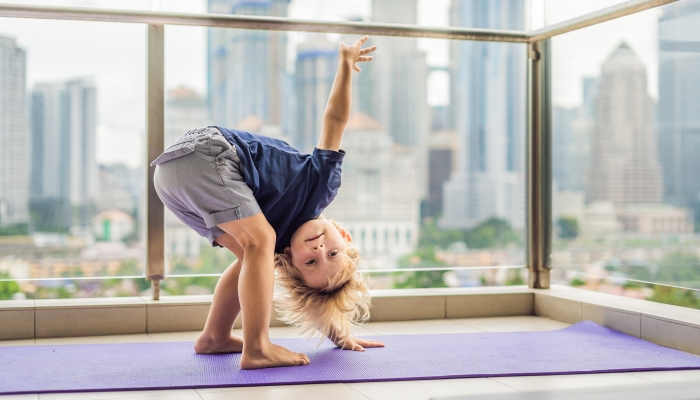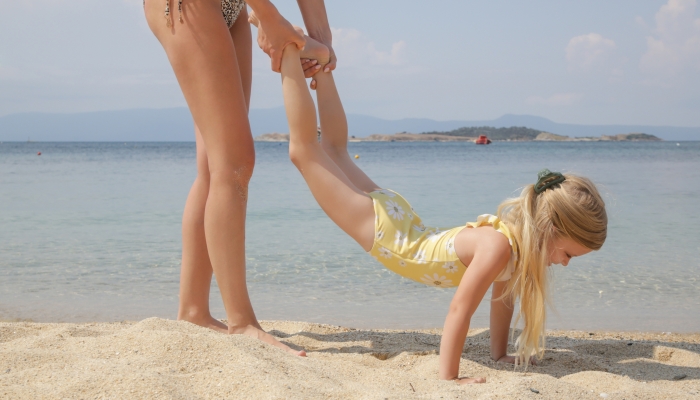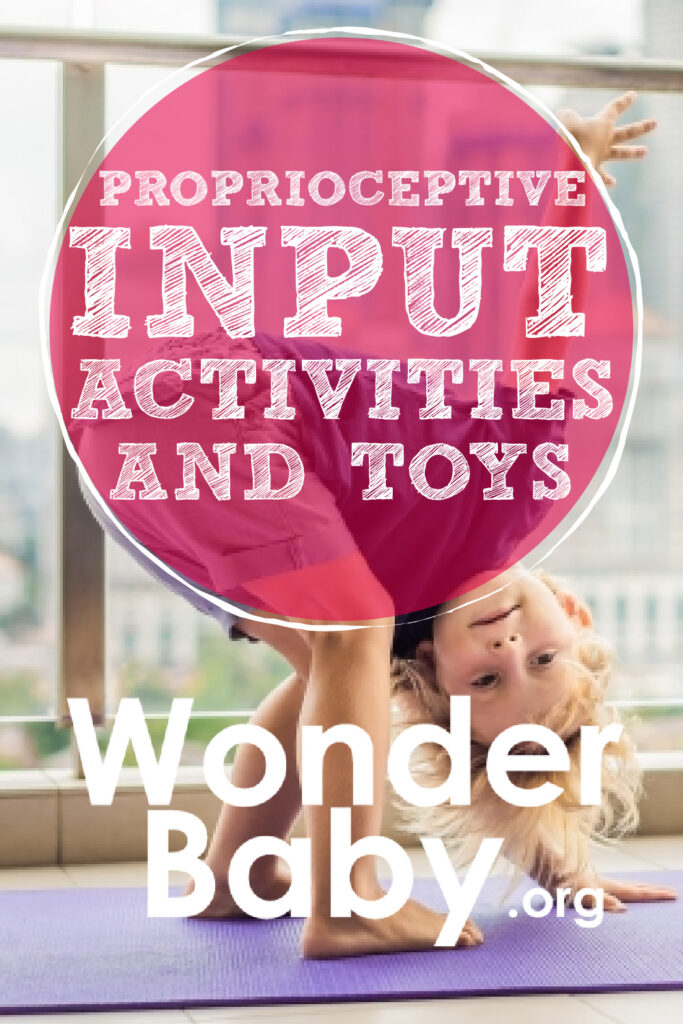11 Proprioceptive Input Activities and Toys

This post may contain affiliate links; please see our terms of use for details.
- Proprioception is an extra sense that tells us where our bodies are in space and where our body parts are in relation to themselves.
- Development of proprioception occurs throughout childhood and may be delayed in some children.
- Poor proprioception may appear as clumsiness, decreased coordination, or poor sensory regulation.
- Many activities and toys can be used to practice proprioceptive skills in the comfort of your own home or local park.
If you have ever marveled at the way humans move through space without toppling over or navigate a crowded event without bumping into everyone, you may be surprised to know that there is a “sixth sense” called proprioception. Proprioception is an awareness of where our body parts are located in relation to each other and the environment.
Conversely, if your child seems to trip over their own feet or weave around bumping into things, you may have concerns about their development.
Luckily, since proprioception is involved in all of our movements, it is a sense that can be exercised anywhere and almost anytime.
What Is Proprioceptive Input?
Many people know the five senses, like smell and sight, that help us to understand and interact with the world around us. A lesser-known sense, proprioception, also exists to help us understand our internal environment. Information our brain receives from proprioceptive receptors found in skin, ligaments, muscles, and joints tells us where our body is in space and in relation to itself.
Proprioceptive input includes stretching, forceful contraction, pressure, and the sensation of movement within these body tissues. The brain interprets this combination of sensory information, allowing us to interact with and move through our environment while maintaining our balance and avoiding injury.
How Important Is Proprioceptive Input to a Child’s Development?
As with any other sense, proprioception develops with practice and exposure. For some children, proprioception does not develop as expected, leading to problems with balance, coordination, posture, and fine and gross motor delay. Kids with decreased proprioception may also experience decreased body awareness and difficulty with sensory processing.
The proprioceptive system helps us to do things as simple as picking up a pencil or maintaining an upright posture while we walk around. If proprioceptive input from muscles is lost or not processed correctly, the brain will have difficulty perceiving body position. Thus, children who do not receive or process the correct amount of proprioceptive input may struggle with any number of movement tasks.
Other children may have challenges with internal regulation due to poor sensory processing. It is not uncommon to see this with children who have Autism Spectrum Disorders. Decreased sensory processing can lead to feelings of sensory overload, where disorganization of incoming stimuli, or input from the environment, can lead to meltdowns or challenging behaviors.

How to Tell If a Child Has Challenges With Proprioception
Not every child’s proprioceptive system will develop at the same rate. Children with structural differences or injury to their neurological system may have significant challenges with proprioception. Damage to individual joints or structural differences in joints, bones, muscles, or skin may also lead to difficulties with proprioception.
Signs of poor proprioception can vary significantly between children. These signs do not necessarily indicate poor proprioception and may indicate other problems with motor planning, sensory processing, or body systems. If you are concerned about your child’s sensory or motor development, please contact their pediatrician or physical or occupational therapist.
Signs that may indicate problems with your child’s proprioceptive system:
- Difficulty keeping up with other children during play activities
- Unusual walking patterns, tripping, or frequent falls
- Poor body awareness, such as a lack of ability to identify commonly known body parts
- Frequently collides with objects or other people by accident or on purpose
- Strong sensory-seeking behaviors, like crashing into objects, self-harm, or stimming behaviors
- Lack of coordination while completing developmentally appropriate activities
- Low muscle tone
4 Fun Proprioceptive Input Activities for Children
While proprioception is commonly addressed in physical and occupational therapy, there are a number of proprioceptive activities you can play with your child at home (or even out in the community)! Many of these activities can be done without breaking the bank. All you need is a little imagination!
1. Yoga Poses
This activity provides much of the sensory input relevant to proprioception training: stretching, muscle contraction, and careful placement of the body in space. To improve your child’s ability to get into a pose, place a mirror in front of your child’s body for added visual feedback.
If you are unsure where to begin, it is becoming easier and easier to find videos or books that give guided yoga instruction just for children. Cosmic Kids Yoga is a fun series of videos that follow a storyline while also introducing easy yoga poses for kids.
2. Balance Exercises
Toe taps: Using small cones (or water bottles!), have your child stand on one leg and reach out with the other leg to tap the object lightly. For a greater challenge, put cones around your child in all four directions and have them tap all of the objects before setting their foot down.
Bird dogs: Starting from a hands-and-knees position, have your child reach with one arm forward and the opposite leg backward and hold for a couple of seconds before switching sides. This is a difficult exercise and may require support around the trunk from the parent.
3. Sensory Activities
Wheelbarrow walk: Hold your child’s feet while they walk forward on their hands. Other bodyweight exercises can help the body’s ability to sense where it is in space (e.g., monkey bars and push-ups).
Heavy lifting: If you are worried that lifting heavy things sounds like a chore, don’t be! Children love to prove how strong they are. Have them push, pull, or lift a weighted ball or household object like a water jug or bin of toys. Even helping with household chores can provide the heavy work many children crave.
Jumping: Jumping requires coordination and control and it helps children develop balance and proprioception as they learn to control their bodies in mid-air and land safely. Jumping is also a great way to get some energy out!
Deep pressure: Gently but firmly provide pressure to your child’s trunk if they begin to show signs of sensory overload. Deep pressure may help to avoid a sensory meltdown and provide the proprioceptive input they need to self-regulate.
4. Obstacle Courses
Obstacle courses are a great way to combine a variety of exercises to keep things interesting! Using playground equipment to mix things up can be just as much fun as an obstacle course at home.
7 Toys That Encourage Proprioceptive Input
1. Balance Beam
A classic balance tool that can easily be bought, made, or found around town, the balance beam is a great way for kids to develop postural control and stability in the hips and ankles. Have your child place each foot all the way in front of the other, preferably landing heel first on the beam.
2. Balance Stones
- Promote Balance and Coordination – This 12-piece stepping stones set promotes physical activity and active play, inspiring your child to jump, stretch, climb, and balance for full-body exercise.
- Bright, Colorful Blocks – Our kid’s stepping stones come in four gender neutral colors for boys and girls to play alone or together, including yellow, red, blue, and green.
- Indoor and Outdoor Play – Special Supplies balancing blocks are durable enough to be enjoyed almost anywhere! Their rugged nature and full rubber, slip-resistant bottoms make them safe for carpet, tile, and grass.
- Kid-Friendly, Kid-Safe Fun – These balancing stones feature a non-slip rubber edge to reduce slipping or accidents. Our durable design can handle as much as 220 lbs. body weight to accommodate children, teens and adults.
There are a number of variations on this tool, with firm, graded mountain-like stones or air-filled half-circles with sensory bumps. Children will love walking across them while pretending to cross a river or while completing an obstacle course.
- COMPLETE BALANCE SET: Balance trainer set includes a hand pump for quick & easy setup; With dimensions of 6.25-inch width & 3.15-inch height, balance pod fits all feet sizes, allowing comfortable practice with or without socks and shoes
- HIGH – QUALITY MATERIAL: Crafted from phthalates PVC with no heavy metal elements, tactile balance domes are durable & flexible; Each balance toy supports up to 440 lbs, suitable for both youth and adult fitness activities
- TWO – SIDED DESIGN: Hedgehog balance pods feature a pebble-textured surface to massage, while a smooth, flat bottom for stability; Balance training can be used flat side down for stability or flat side up to increase challenge
- IMPROVE BALANCE & STABILITY: This foot pod set enhances dynamic balance, body awareness, and coordination. Designed to massage sore feet, acupressure, fallen arches, plantar fasciitis, bunions & hammertoes
3. BOSU
- Multipurpose Workout Ball: Combines elements of cardio, strength, and flexibility into unique and highly effective workouts; Forces you to maintain your center of gravity while performing any exercise
- Muscle Engagement: 26-inch balance ball increases the difficulty of workouts and builds your strength faster by forcing the engagement of more muscles
- Versatile Balance Dome: Balance trainer improves your flexibility, endurance, strength, and overall ability by allowing you to perform multiple and versatile workouts
- Good for Rehabilitation: Not just for exercise, this workout ball can be used as an equipment for rehabilitation and physical therapy with the help of its unstable surfacing
A great piece of exercise equipment for kids and adults alike, the BOSU can be used many different ways. For a fun way to train proprioception, have your child stand on the bubble or flat side and throw to a target or complete a ring toss. For challenging core exercises, try a boat pose or superman exercise while sitting or lying on the bubble side.
4. Exercise Ball
- ANTI-BURST – Our exercise ball features a patented wire frame structure, making it resistant to bursting and ensuring it deflates slowly if punctured. This design minimizes the risk of injury from falls, providing you with a level of safety reminiscent of a caring parent.
- ANTI-SLIP SURFACE – Our Swiss ball ensures stability for home, gym, or outdoor use. It’s perfect for various activities like yoga, pregnancy workouts, and pilates. Additionally, it can serve as an office ball chair, helping improve posture and alleviate back pain while engaging your core. Enjoy effective strengthening and deep stretches during or after your workday.
- TOP QUALITY MATERIAL – Our exercise ball stands out among its peers. It’s rigorously weight-tested and can support up to 330 lbs. Constructed from high-quality, non-toxic PVC, it’s free from BPA and other harmful materials.
- EASY TO INFLATE – Time is precious! Our exercise ball simplifies your life with a quick-inflation pump included, along with two air stoppers and clear instructions. It comes in multiple sizes to cater to your specific needs.
Supporting your child on an exercise ball while gently rolling the ball in any direction helps children to strengthen their core muscles, meet their sensory needs, and develop postural control. Bouncing your child on the ball will provide even more proprioceptive input!
5. Wii
If you are looking for a game console for your kids, the Wii has some great features that allow children to work on proprioceptive activities. The Wii has a sensor and a balance board that will provide visual feedback so the player may see where their body is in space or where their center of gravity over the board is located. The added visual feedback helps the brain process the sensory information it is already receiving from muscles and joints.
6. Cushions/Pillows
These are great alternatives to pricier balance equipment that will still improve your child’s ability to process proprioceptive input. Use pillows and cushions for deep-pressure activities such as making your child into a “sandwich” or having gentle pillow fights.
7. Blankets
No products found.
Wrap your little one up like a caterpillar to roll on the floor or use a weighted or heavy blanket to give calming sensory input.
FAQs
At what age does proprioception mature?
Proprioception begins to develop in infancy as a baby starts to move and explore their environment. Sensorimotor function continues to improve and develop throughout childhood and may not be fully mature until adolescence or young adulthood.
How do you test a child for proprioception?
Testing for proprioception would typically be completed by a physical or occupational therapist, neurologist, or orthopedist. Tests may assess balance, coordination with eyes open or closed, walking, and other movements. However, if your child seems clumsier than their peers, falls frequently, or becomes upset with too much or too little sensory input, discuss your concerns with their care provider.
Does proprioception decline with age?
Though proprioception will not be fully developed until adulthood, this sense also declines with age. Older adults experience a decline in proprioceptive sense that may contribute to an increased risk of falls, decreased postural control, and decreased ability to complete cognitive and motor tasks simultaneously.
How can these activities be completed safely?
- COW&COW Gait Belt
Working on proprioceptive activities may make you nervous, especially if your child is prone to injury or falls. Providing verbal encouragement and light support at the hands, hips, or trunk will help your child to feel confident and safe as they are learning to work on proprioceptive activities. As your child progresses with these activities, gradually decrease your support. A gait belt may be used for children with significant fear or difficulty in standing positions.

The information WonderBaby provides is not intended to be, and does not constitute, medical or other health advice or diagnosis and should not be used as such. Always consult with a qualified medical professional about your specific circumstances.
Related Posts

Eye Conditions and Syndromes, Visual Impairment
Neuralink Announces Plans to Restore Sight to the Blind with Brain Chip
Elon Musk’s company Neuralink has announced plans to begin human trials of its new “Blindsight” brain chip by the end of 2025.

Special Needs
5 Spring Cleaning Tips for Families of Children with Disabilities
Spring cleaning is an opportunity to create a more accessible, organized, and supportive space for your child with disabilities. Declutter, deep clean, and refresh!

Visual Impairment
The Gift of Understanding: How a Young Child Helps His Blind Father Navigate Life
When a parent is blind, it’s natural for people to wonder how their sighted child will adapt. Will they struggle to understand their parent’s needs? Will they feel burdened by...





